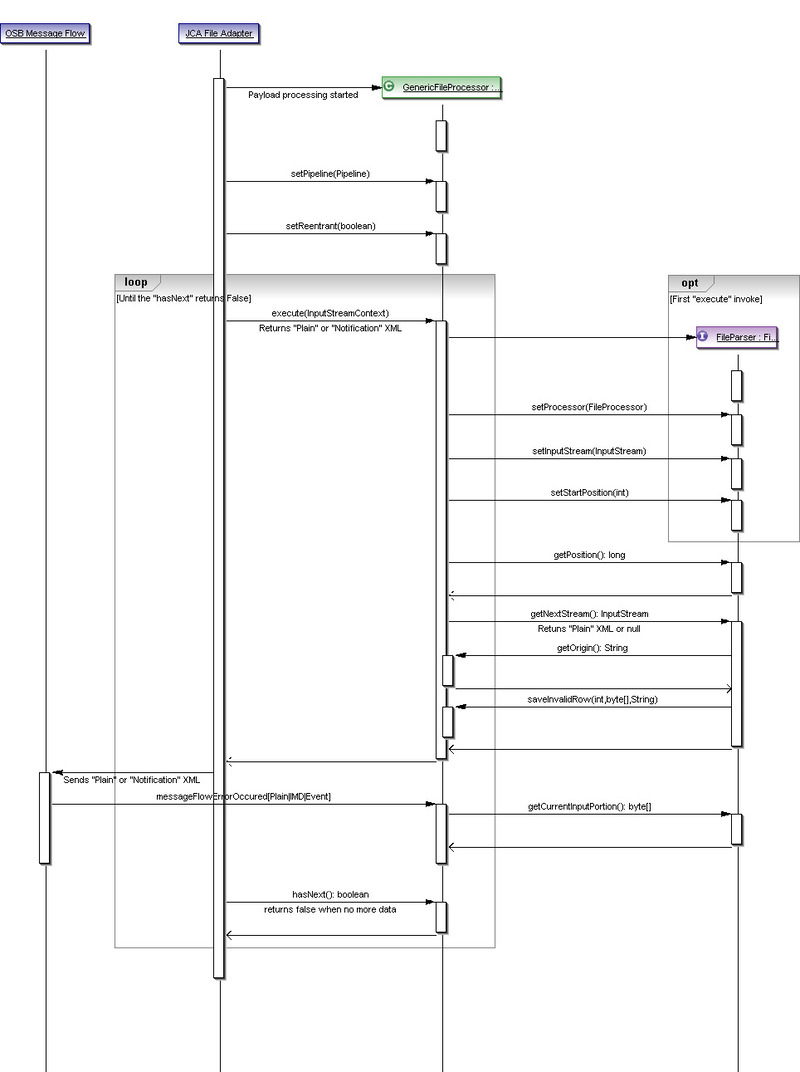Logic Sequence Diagram
The sequence diagram below is helpful for understanding the File Parser functionality. The custom class must implement the FileParser and FileParser2 Java interfaces described in the SGG D1 jar to be qualify as a file parser. For more information, see FileParser Interface and FileParser2 Interface.

When FA finds a file in the input directory, it instantiates and calls GFP which in turn starts an interaction with the FP. The interaction can be categorized into the following three phases:
-
Instantiation and Initialization
-
setProcessor()
-
setInputStream()
-
setStartPosition()
-
-
Transaction
-
getPosition()
-
getNextStream()
-
-
Exception Handling
-
getCurrentInputPortion()
-
Instantiation and Initialization Phase
The GFP is instantiated and receives an Input Stream when a file gets into the input directory. At that point an instance of the FP is instantiated. Certain methods, as specified above, are invoked on the FP to initialize.
Transaction Phase
Once the FP is initialized, GFP uses the FP instance to generate the Plain XML structure. This happens with the invocation of getNextStream() method on the FP.
On every invocation, the FP returns exactly one Plain XML. The FP invocations continues until NULL is returned from the FP. NULL indicates the end of file and an indication that parsing is complete for a specific file. GFP stops invoking getNextStream() for a particular input file when it receives a NULL from the FP.
FP uses the file input stream to read the file in portions. It could read byte-by-byte or line-by-line, but at the end of each getNextStream() method call it would have read only so much that is sufficient to create one Plain XML structure. For example, in an input file, if there is sufficient data for only one Plain XML then the first call to getNextStream() would return a Plain XML and the next one would return NULL. But if there is more than one, getNextStream() calls would continue to return Plain XML structures for every incoming portion until end of file is reached.
Exception Handling Phase
Exception handling inside the FP can be categorized into two phases: Reactive and Recovery:
Reactive Phase
This phase involves catching an exception and reporting it to the GFP. It is achieved by invoking saveInvalidRow() method on the GFP (this.fileProcessor).
Note that when an exception occurs, no further parsing is done and NULL is passed back from getNextStream().
If one fails to return NULL, errors such as “Simultaneous good and bad result returned by the File Parser” can be found in the Weblogic server log.
When an exception is reported to the GFP, it does three things:
-
Creates an XML payload D1-PayloadErrorNotif and passes it to the OSB message flow. The message is published to the Notification Queue from inside PPS of the BASE OSB project.
-
It increments the “transaction error occurred” variable by invoking the utility method inside the D1 jar. All the errors occurring during the lifetime of a file parsing are captured and are reported through the message D1-PayloadSummary - which is again published to Notification Queue.
-
Finally, it creates a data file in the error directory with the portion of raw data that is read when the error occurred. It also creates a Rejected File Descriptor (RFD) file. The raw input portion is available by utilizing getCurrentInputPortion() method, which is discussed below.
As noted in the above image, the saveInvalidRow() method takes three input parameters:
-
The position at which the parsing started. It will be written to an RFD file. This is helpful in identifying the location of an error in the input file.
-
The raw data that will be written into error data file. It should be in the same to the incoming file format and it should contain data that is read since current invocation of getNextStream() method is started. It will allow correcting troubled data and place “fixed” file into an incoming folder for further re-processing.
-
The error message that is reported in D1-PayloadErrorNotif message. Note, the content of the error message has to be defined by the file parser developer.
Recovery Phase
This phase must not be confused with recovering from a handled exception discussed above. This case is when file parsing gets completely interrupted by power failure or network interruption.
Preparation for recovery: GFP maintains an internal index to the current read position of the file. This is achieved by GFP by invoking getPosition() method on the FP before every getNextStream() method call.

Recovery: In case of an interruption and subsequent restore, GFP sets the start position on the File Parser. For instance, if the failure had occurred at byte 415, the start position would be set to 415 so that FP starts to read from that point and not from 0. The value 415 can be referred to as the recovery point.

When the file parser starts parsing again, two things must occur to ensure that it starts parsing from the recovery point:
-
Store the recovery point to the startPosition field.
-
Incorporate skip logic to start the pointer from the recovery point.
